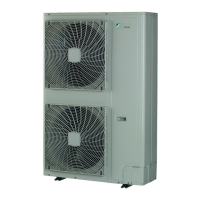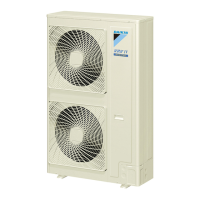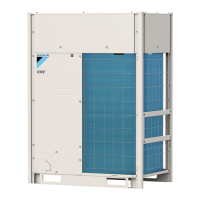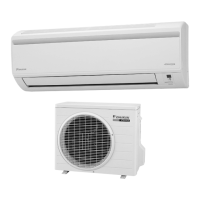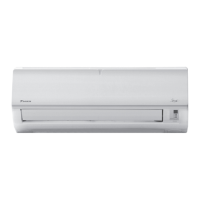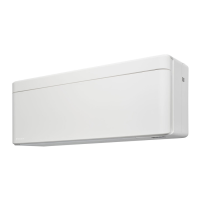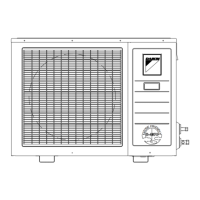12 Special requirements for R32 units
Installation and operation manual
18
SV1A25AJV1B+SV4~8A14AJV1B
VRV 5 safety valve unit
4P709466-1 – 2023.09
Replacement
air
Make sure that sufficient replacement air is
available for the extraction of a refrigerant leak.
The extraction airflow rate must be maintained for
at least 8hours. This is achieved by providing a
sufficiently large air volume around the SV unit or
by providing sufficient replacement air around the
SV unit (e.g. natural openings or a dedicated
opening in the false ceiling).
Maintenance Maintain the evacuation channel to avoid dust and
dirt from building up and obstructing the flow path.
One SV unit – one extraction fan
In the most simple configuration, each SV unit in the system has its
own evacuation channel and its own extraction fan.
a SV unit
b Ductwork
c Extraction fan
An extraction fan must be connected to the SV unit, see "15.6 To
connect the external outputs"[436].
In order to size the fan, calculate the required pressure capacity. The
total pressure drop in the evacuation channel consists of multiple
parts: the pressure drop generated by the SV unit and the pressure
drop generated by the components of the ductwork.
Select an airflow rate for the evacuation that meets the legal
requirements. This means that the airflow rate is above the legally
required minimum, and generates sufficient pressure difference
inside the SV unit when compared with the pressure of the
surroundings. The minimum required airflow rate (AFR
OUT
) is
18.8 m³/h, and the pressure drop generated by the SV unit should
lead to a pressure inside the SV unit (P
internal
) that is more than 20Pa
below the pressure of the surroundings.
a SV unit
AFR
OUT
Airflow
P
internal
Internal pressure
It is advised to take a safety margin on these minimum values when
designing the evacuation channel in order to account for tolerances
on parts, dirt and dust building up in the evacuation channel over
time, etc.
Note: The internal pressure of the SV unit should not be more than
350Pa below the pressure of the surroundings.
Write down the pressure drop generated by all the components in
the evacuation channel for the selected airflow rate. For the SV unit,
use the curve that presents the pressure at the outlet (P
OUT
) in
function of the airflow rate (AFR
OUT
). See the latest version of the
technical engineering data for the pressure drop curves of the SV
unit.
a SV unit
AFR
OUT
Airflow
P
OUT
Outlet pressure
For the pressure drop caused by other components of the
evacuation channel (ducts, bends, etc.), use the curves of the
manufacturer.
Use the airflow rate and the sum of the pressure drops to select a
suitable fan.
Example
a SV unit
b~h Ductwork (duct, bend, reducer, expander, non-return
valve, wall grill, etc.)
i Extraction fan
In this example we use a SV8A unit. Use the curve of the internal
pressure inside the SV unit (P
internal
) in function of the airflow rate
(AFR
OUT
). When an airflow rate of 115m³/h is selected, the pressure
inside the SV unit is 38Pa below the pressure of the surroundings.
So this airflow rate is above the required 18.8m³/h and the pressure
inside the SV unit is within the range of 20~350 Pa below the
pressure of the surroundings. We use this 115 m³/h airflow rate for
further calculations.
Note: These curves present the internal pressure of the SV unit
compared to an ambient pressure of 101325Pa.
Use the curve of the outlet pressure (P
OUT
) in function of the airflow
rate (AFR
OUT
) for the SV unit. With an airflow rate of 115 m³/h, the
resulting pressure drop generated by the SV unit is 38.3Pa.
Use the curves, with instructions how to read them, of the
manufacturer of the components to find the pressure drop generated
by all components in the ductwork. A conversion of units might be
required. Beware that for ducting, the pressure drop from the
manufacturer might be given per unit length of ducting (units are for
example Pa/m). Multiply this value by the duct length to find the total
pressure drop.
Write down the pressure drop of each component in an overview
table. Sum up the pressure drops.
Nº Indication Type AFR [m³/h] Length [m] ∆P [Pa/m] ∆P [Pa]
1 a SV unit 115 - - 38.3
2 b Duct “ 5 1 5
3 c Bend “ - - 8
4 b Duct “ 10 1 10
5 c Bend “ - - 8
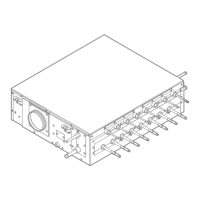
